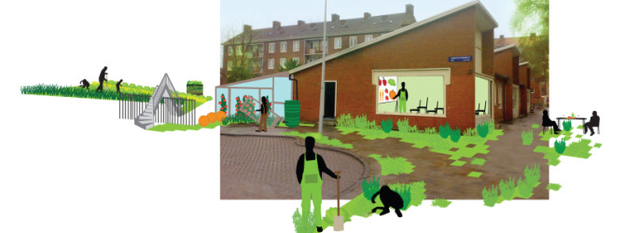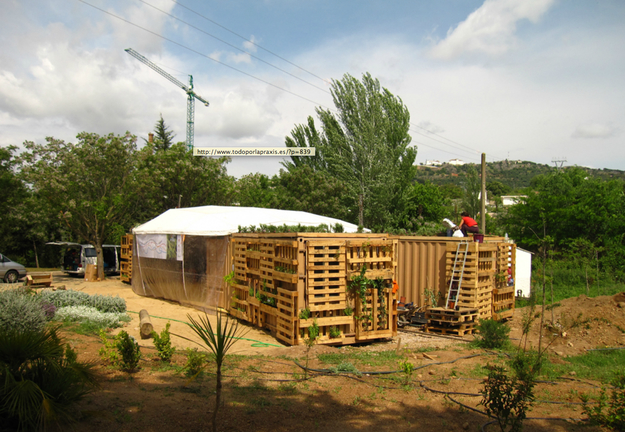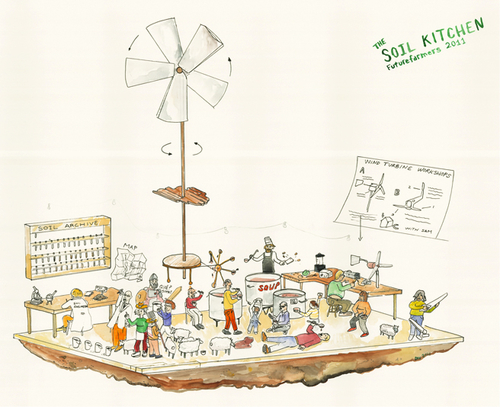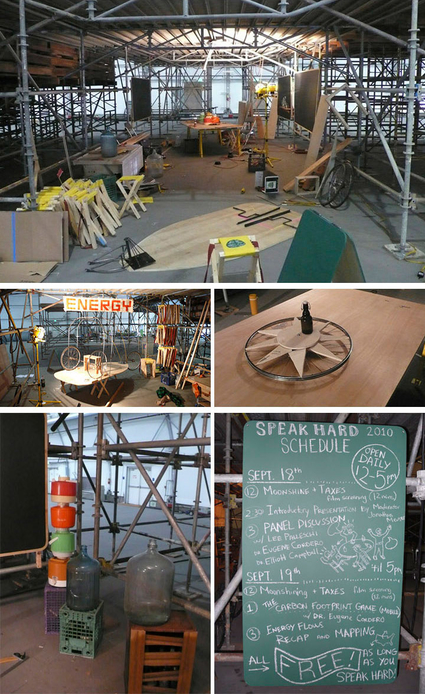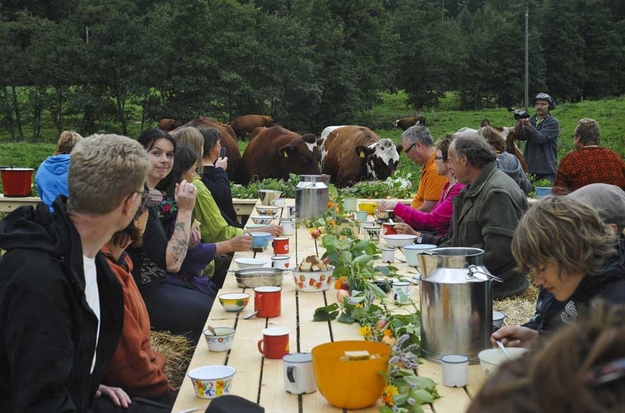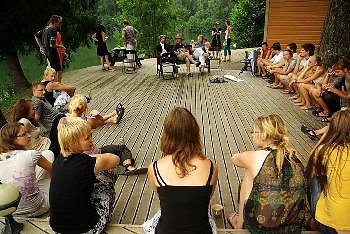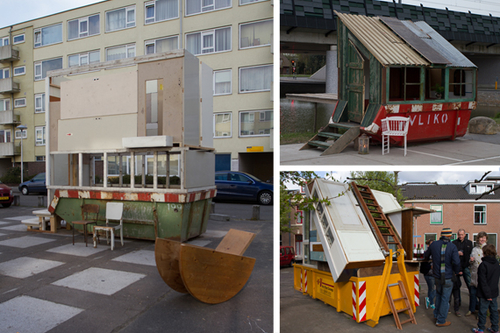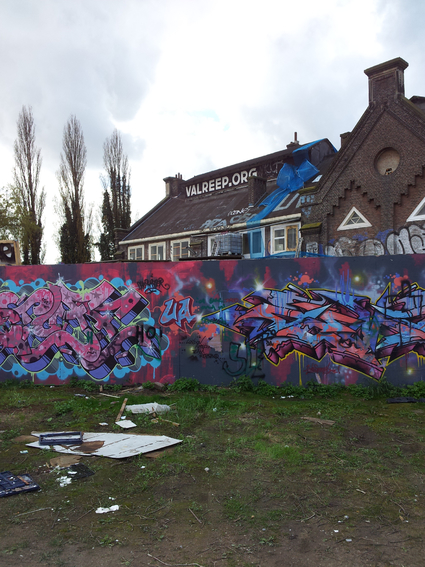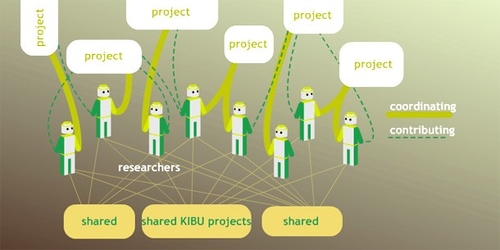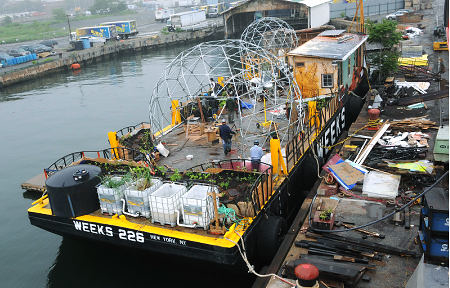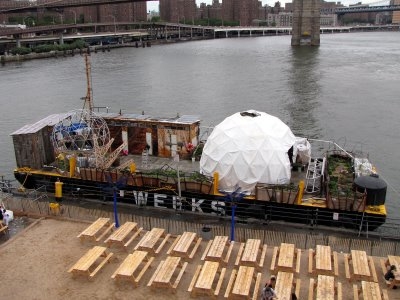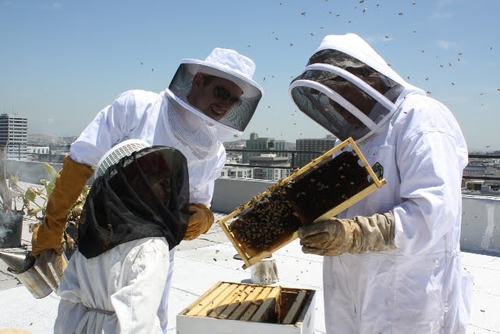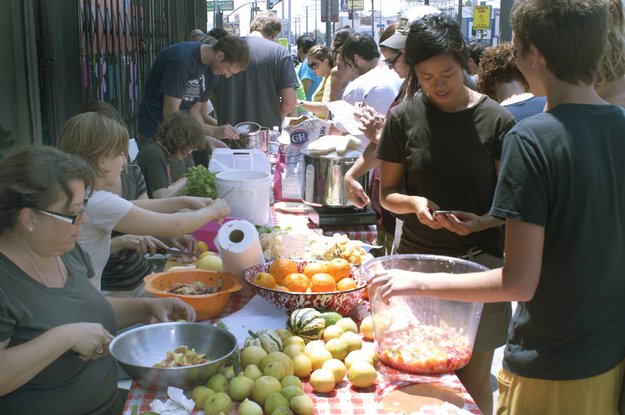HortoLab
Who?
This project is a design collaboration by Straddle3 , Recetas urbanas, Proyecto aSilo and Todo por la Praxis design collective groups from Spain.
What?
HortoLab is a project for and by the community based on three second-hand shipping containers which are joined by a roof of recycled material of a road railing. This structure was covered with plastic sheeting and the floor was paved with shuttering board.
Why?
A kitchen lab, a office and a seed bank where there will be activities dedicated to the creative cuisine of seasonal vegetables, kitchen recycling among others activities and workshops.
Soil Kitchen
Who?
Artists Dan Allende, Ian Cox, Amy Franceschini and architect Lode Vranken.
What?
They have created the Soil Kitchen as a temporary windmill-powered architectural intervention and multi-use space where citizens enjoy free soup in exchange for soil samples from their neighborhood.This exchange provides an entry point for further dialogue and action available in the space through workshops, events and informal exchange.
Soil test results, click here
Why?
Soil Kitchen is a good community strategy to re-establish natural urban value and tools to inform the neighborhood.
The Speak Hard
Who?
Created by the artist Amy Franceschini and Dan Allende.
What?
The Speak Hard is a platform that provokes dicussions on the subject of the future of fuel, and invites scientists, moonshiners and policy makers to discuss their research with the public.
Why?
Interesting space of information exchange.
Lunch with cows
Who?
What?
Lunch with cows is an experimental cooperation of organic farming and visual art practice,
situated in rural village Dyestad, on the island Öland on the southeast coast of Sweden.
By installing certain functions in abandoned farm facilities, near to the active agriculture community.
Why?
Kultivator provides a meeting and working space that points out the parallels
between provision production and art practice as Mediamatic Fabriek could think about to.
Urban Lab
Who?
Urban Lab is a testing ground for urban innovations
What?
With Urban Lab they work on new solutions to improve and diversify the urban life. As the name tells, the Lab is all about experimenting. Our projects involve scientific, social and artistic methods
Why?
In Mediamatic we want the active participation of citizens for sustainable development of the urban society.
Straatlokaal
Who?
Foundation Projects is a concept by Rikkert Paauw and Jet van Zwieten.
What?
In Straatlokal project they work collecting waste material and old furniture from the neighborhood, moving it to a waste container, reusing it to turn it into a small house (with a container), to become a temporary meeting place for neighbors.
Why?
In Mediamatic we want the neighbors to get involve in the community and work with reusing materials.
Op de Valreep
Who?
A group of squatters in close collaboration with the community.
What?
It is a cultural space, open to the community, where activities such as workshops, concerts, film screenings etc. are hosted and where people can get together and make things happen. Op de Valreep also has a garden, cultivated by those willing to participate.
Why?
This project is an example of a successful community collaboration that contributes to its neighbourhood. At Mediamatic we believe in the importance of community involvement and therefore support initiatives such as this one.
Kitchen Budapest
Who?
Kitchen Budapest is a new media lab for young researchers based on Hungary.
What?
They are interested in the convergence of mobile communication, online communities and urban space and are passionate about creating experimental projects in cross-disciplinary teams.
Why?
At Mediamatic we want to improve the urban space and give the tools to the people to do it.
The Water Pod project
Who?
The New York-based artist Mary Mattingly designed the project The Waterpod, an eco-floating habitat evoking the works of Buckminster Fuller, Andrea Zittel, Robert Smithson & Constant Niewenhuis.
What?
The Waterpod structure was built on a deck barge where systems were installed to generate food, water and energy. Four cabins were built for a group of resident artists and communal areas were built for the artists and visitors. The Waterpod was to be a free and participatory public space in the waterways of New York City.
Why?
In the Fabriek area, it could create an environment that included both public resources and a private experiment, an aquatic and terrestrial, interior and exterior mobile hybrid.
Urban beekeeping
Who?
Backwards Beekeepers is a group of organic, treatment-free beekeepers in Los Angeles, with branches now forming in other cities.
What?
They rely on observation and natural practices to keep the bees thriving rather than pesticides, chemicals, or treatments of any kind. Bees are essential for our biodiversity. As a consequence, by participating to this sustainable project, any neighborhood can produce its own honey in community workshops.
Why?
Mediamatic is looking forward to create a neighborhood stimulation via community workshops like beekeeping for example.
Fallen Fruit
Who?
Fallen Fruit is an art collaboration that began with creating maps of public fruit: the fruit trees growing on or over public property in Los Angeles and other American cities.
What?
Their art work includes an ongoing series of narrative photographs, videos, public events or collaborative performances, public-service posters for bus shelters as well as interactive installations and murals.
Using fruit as their lens, Fallen Fruit investigates urban space, ideas of neighborhood and new forms of located citizenship and community. From protests to proposals for new urban green spaces, they aim to reconfigure the relation between those who have resources and those who do not, to examine the nature in and the nature of the city, and to investigate new, shared forms of land use and property.
Why?
Fruits can be considered to be many things. Conceptually speaking, it’s a subject, an object, a noun, a thing, and a symbol. Fruit often triggers a childhood memory, it’s emotional, familiar to most everyone on the planet. Everyone has a fruit story, so how about to share it!
